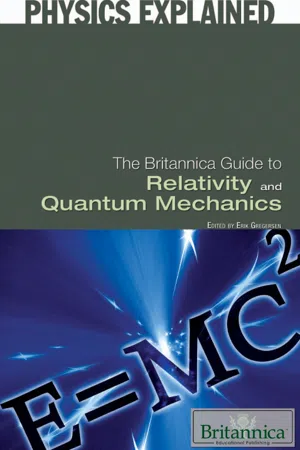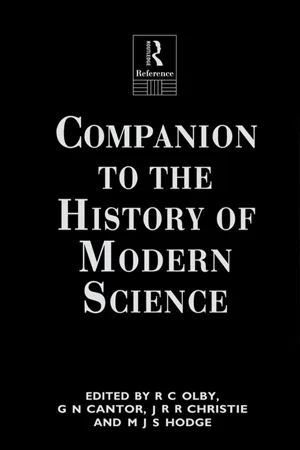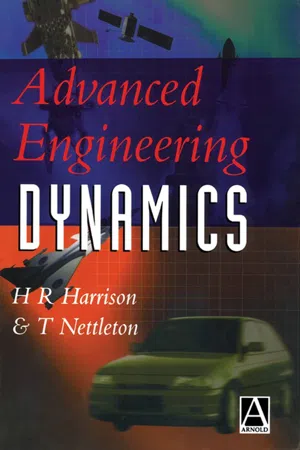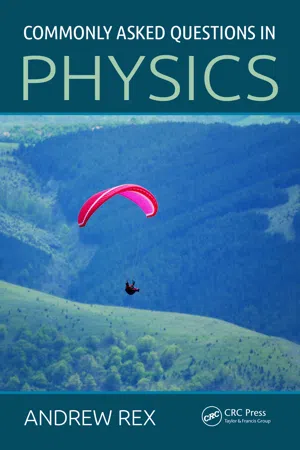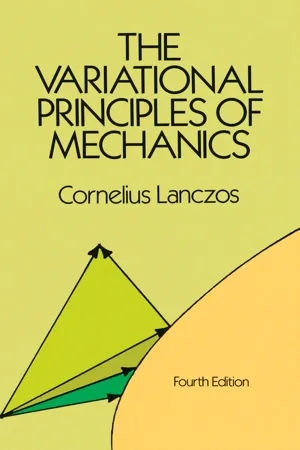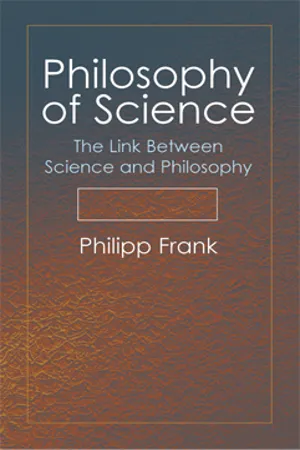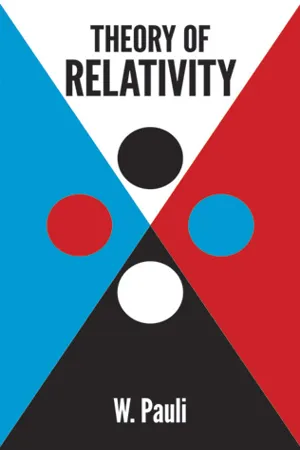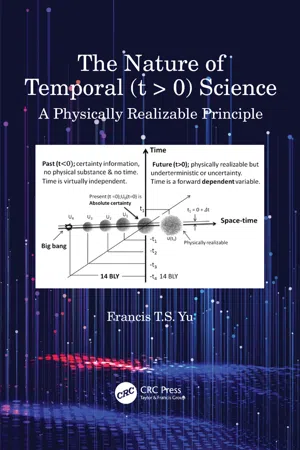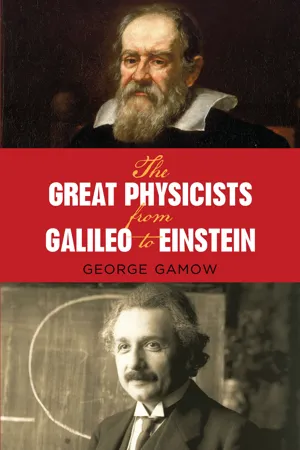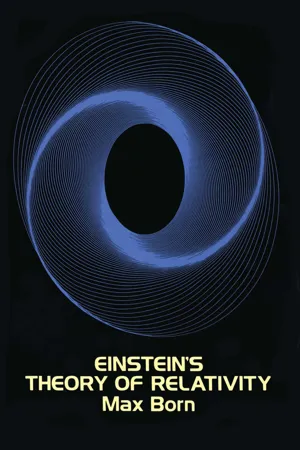Physics
Relativistic Mechanics
Relativistic mechanics is a branch of physics that describes the motion of objects at speeds approaching the speed of light. It is based on Albert Einstein's theory of special relativity, which revolutionized classical mechanics by introducing concepts such as time dilation, length contraction, and the equivalence of mass and energy (E=mc^2). Relativistic mechanics provides a more accurate description of motion at high speeds than classical mechanics.
Written by Perlego with AI-assistance
Related key terms
12 Key excerpts on "Relativistic Mechanics"
- Britannica Educational Publishing, Erik Gregersen(Authors)
- 2010(Publication Date)
- Britannica Educational Publishing(Publisher)
CHAPTER 1 RELATIVITYW ith his theories of special relativity (1905) and general relativity (1916), German-born physicist Albert Einstein overthrew many assumptions underlying earlier physical theories, redefining in the process the fundamental concepts of space, time, matter, energy, and gravity. Along with quantum mechanics, relativity is central to modern physics. In particular, relativity provides the basis for understanding cosmic processes and the geometry of the universe itself.THE MECHANICAL UNIVERSE
Relativity changed the scientific conception of the universe, which began in efforts to grasp the dynamic behaviour of matter. In Renaissance times, the great Italian physicist Galileo Galilei moved beyond Aristotle’s philosophy to introduce the modern study of mechanics, which requires quantitative measurements of bodies moving in space and time. His work and that of others led to basic concepts, such as velocity, which is the distance a body covers in a given direction per unit time; acceleration, the rate of change of velocity; mass, the amount of material in a body; and force, a push or pull on a body.The next major stride occurred in the late 17th century, when the British scientific genius Isaac Newton formulated his three famous laws of motion, the first and second of which are of special concern in relativity. Newton’s first law, known as the law of inertia, states that a body that is not acted upon by external forces undergoes no acceleration—either remaining at rest or continuing to move in a straight line at constant speed. Newton’s second law states that a force applied to a body changes its velocity by producing an acceleration that is proportional to the force and inversely proportional to the mass of the body. In constructing his system, Newton also defined space and time, taking both to be absolutes that are unaffected by anything external. Time, he wrote, “flows equably,” while space “remains always similar and immovable.”- eBook - ePub
- G N Cantor, G.N. Cantor, J.R.R. Christie, M.J.S. Hodge, R.C. Olby(Authors)
- 2006(Publication Date)
- Routledge(Publisher)
28 The Theory of Relativity John Stachel DOI: 10.4324/9780203191873-34‘The theory of relativity’ is an umbrella term for two distinct theories, the special theory and the general theory. Both might not bear this common appellation if they were not so closely associated with the name of Albert Einstein (1879-1955), who developed the second in an attempt to generalise his original theory of relativity, now called the special theory.Einstein often compared the principles of special relativity to those of thermodynamics. Each theory starts with a few principles, which incorporate a wealth of empirical data into generalisations at a high level of abstraction. For thermodynamics, these principles generalise the failure of attempts to construct perpetual motion devices. For special relativity, they generalise the failure of attempts to distinguish a state of absolute rest from states of uniform trans-lational motion.These principles are used to derive criteria that must be satisfied by constructive theories at a lower level of abstraction. For special relativity, these criteria are kinematical: the laws of physics are the same in any inertial frame of reference, i.e. they are invariant in form under a group of spatial and temporal transformations, called the Lorentz group.The general theory of relativity is a theory of gravitation. In contrast to the other forces of nature, gravitational effects are a result of the structure of space and time; modifications of which can be brought about by the distribution of matter and energy, which act as sources of the gravitational field. Hence, space, time, matter, energy and gravitation are inextricably intertwined. Whether the resulting theory is a theory of ‘relativity’, in some sense of the word analogous to its use to describe the special theory, is still actively debated by physicists and philosophers of science.Einstein regarded the theory of the free gravitational field (i.e. in the absence of matter and other non-gravitational fields) as his major accomplishment. However, he was not satisfied with the treatment of the sources of the gravitational field in general relativity. These sources must be specified by additional field or particle variables, which are independently and arbitrarily introduced into the theory. Einstein hoped to find some mathematical structure to serve as the basis of a ‘unified theory’ of the gravitational and electromagnetic fields, without the introduction of any additional entities. - eBook - ePub
- H. Harrison, T. Nettleton(Authors)
- 1997(Publication Date)
- Butterworth-Heinemann(Publisher)
9Relativity
9.1 Introduction
In this chapter we shall reappraise the foundations of mechanics taking into account Einstein’s special theory of relativity. Although it does not measurably affect the vast majority of problems encountered in engineering, it does define the boundaries of Newtonian dynamics. Confidence in the classical form will be enhanced as we shall be able to quantify the small errors introduced by using Newtonian theory in common engineering situations.The laser velocity transducer employs the Doppler effect which, for light, requires an understanding of special relativity. The form of the equations derived for cases where the velocities of the transmitter and/or the receiver are small compared with that of the signal is the same for both sound and light. This will be discussed later.We shall also consider the definition of force. It is of note that relativistic definitions are such that they encompass the Newtonian. The general theory of relativity raises some interesting questions regarding the nature of force, but these do not materially affect the equations of motion already derived.9.2 The foundations of the special theory of relativity
It is not our intention to retrace the steps leading to the theory other than to mention the most significant milestones. In the same way that Isaac Newton crystallized the laws of mechanics which have formed the basis for the previous chapters in this book, Albert Einstein provided the genius that solved the riddle of the constancy of the speed of light.James Clerk Maxwell’s equations for electrodynamics predicted that all electromagnetic waves travelled at a constant speed in a vacuum. If the value of the speed of light, c - eBook - ePub
- Andrew Rex(Author)
- 2014(Publication Date)
- CRC Press(Publisher)
Chapter 9 Relativity Relativity is one of the most important and fascinating fields of study within physics. It’s generally split into two subfields—special relativity and general relativity—both of which were developed by Albert Einstein in the early twentieth century. Relativity accounts for how events are viewed from different frames of reference, when those frames of reference are moving with respect to one another or in strong gravitational fields. It also accounts for how light will appear to observers in different frames of reference. Many of the effects predicted by the theory of relativity are contrary to the predictions of classical physics and to perceptions based on everyday experience. These striking and sometimes shocking predictions have been verified repeatedly by experimental evidence. Probably the most famous prediction of special relativity is the equivalence of mass and energy, expressed in the formula E = mc 2. This equivalence manifests itself in many ways, particularly in atomic and nuclear physics (Chapter 7) and in the study of fundamental particles (Chapter 8). The implications are far reaching and include the production of nuclear energy and nuclear weapons. What’s the Difference between Special Relativity and General Relativity? Special relativity accounts for how material objects and light are viewed by observers traveling in different frames of reference, in constant, nonaccelerated motion with respect to one another. The fact that the speed of light is the same for observers in all reference frames is of fundamental importance. It leads to correct predictions about how the different observers measure the positions, lengths, and velocities of objects, and how they measure the passage of time - eBook - ePub
- Cornelius Lanczos(Author)
- 2012(Publication Date)
- Dover Publications(Publisher)
General relativity cannot be properly treated without the field concept, which belongs to the realm of the mechanics of continua. Our following exposition is thus restricted to the kinematics and dynamics of Special Relativity. However, the dynamical law of General Relativity falls within the scope of Lagrangian and Hamiltonian dynamics and will be included in our discussions.2. Relativistic kinematics. In his fundamental paper Einstein1 introduced the following two postulates:(a) All reference systems that move relative to each other with constant velocity are equally legitimate for the description of nature, without any preference for any particular one of them.(b) The velocity of light c is the same universal constant, measured in any of these systems.The second postulate leads to the following apparent absurdity. Consider an observer B moving relative to A with the velocity of light c. He emits a light signal in the direction of his own motion which moves relative to him with the velocity c. According to our common notions the velocity of this signal relative to A should be 2c, while the second postulate of relativity demands that it is c. Hence c = 2c, which is self-contradictory. This is no longer so, however, if we give up the intuitive notion of a time t which is the same for both observers A and B.According to Einstein we should not prejudice in advance the transformation equations which exist between the coordinates of the system A and those of the system B. Assuming that the motion of B relative to A occurs in the X-direction, we putwhere a, β, γ, δ are constants, since we do not want to lose the linearity of the transformation. But by abandoning the equation t = t′ (which corresponds to the choice γ = 0, δ = 1) we have gained the freedom of two additional constants.All formulae of special relativity gain greatly in simplicity, if we agree to measure the time in such units that the velocity of light becomes unity (this means that the usual time t is replaced by t/c). If we want to return to the formulae involving our ordinary time t, we have merely to change all t to ct and all v to v/c. We shall frequently make use of this simplification and thus agree that the invariant velocity of light has the numerical value c = - eBook - ePub
Philosophy of Science
The Link Between Science and Philosophy
- Philipp Frank(Author)
- 2013(Publication Date)
- Dover Publications(Publisher)
3If you don’t take my words too seriously, I would say this: If we assume that all matter would disappear from the world, then, before relativity, one believed that space and time would continue existing in an empty world. But, according to the theory of relativity, if matter and its motion disappeared there would no longer be any space or time.2. “Relativity” in Newtonian Mechanics
We learned in Chapter 3 that Newton’s laws of motion, which verbally determine acceleration with respect to “absolute space,” can only be used for the prediction of observable facts if they are interpreted as referring to an “inertial system” which is a system of physical bodies. As a first approximation, we can identify this system with the constellations of fixed stars as far as we can regard them as forming a rigid system. Newton had already raised the question of whether we can recognize by mechanical experiment performed in a certain room, whether this room is an inertial system or not, and if so, whether or not it is the only inertial system. If we denote by a in the acceleration with respect to an inertial system (S ), Newton’s laws of motion can be written ma in = f, if m is the mass of a body and f the “simple formula”4 which gives us the Newtonian force. If we disregard for the moment nuclear forces which account for the motion of subatomic particles, the motion of masses of average size is determined, as a matter of fact, by only two types of force, electromagnetic and gravitational. In the first case, if the mass is increased (by adding more pieces of matter) the acceleration a in will decrease according to the formula a in = f/m. With sufficiently increased mass, the acceleration will become infinitely small. This is certainly the case if the force is of the electromagnetic type. If e is the electric charge, and E the electric field strength, we have f = eE and a in = e/m × E. In a given field, the acceleration of an increasing mass relative to the inertial system will decrease toward zero. To the electromagnetic type of force belong all forces of cohesion, among them the forces which are produced if one gives a body a direct push or pull. There is, however, a different type of force. We have known since Galileo that, in the case of freely falling bodies, the acceleration with respect to the earth is independent of the mass. This means that f/m is independent of m or f is proportional to m. If f = mg, it is evident that f/m = g is independent of m. - eBook - ePub
The Language of Modern Physics
An Introduction to the Philosophy of Science
- Ernest H. Hutten(Author)
- 2022(Publication Date)
- Routledge(Publisher)
non-Euclidean geometry, and the character of the geometry depends upon gravitation—that is, the distribution of masses in the universe. Since all reference systems, including accelerated ones, are equally acceptable, the conceptions of straight line and curved line become relativised as well; and Euclidean concepts can no longer be applied. Euclidean space has lost its preferential status, except as Riemann’s ‘flatness in smallest parts’. For the kind of non-Euclidean geometry needed to describe the actual universe passes into Euclidean geometry for infinitesimal regions of space. Gravitation and geometry are linked, and the geometry of physical space is determined by the gravitational field.The general theory of relativity is expressed in non-Euclidean terms depending upon whichever fields exist, and in particular on gravitation. In this manner field and space are fused. Or, the idea of a space—like the space of a room—as an independent system of reference in which events are placed, becomes untenable. Space is the expression for certain physical relations between events ; and when we describe larger areas of the universe, it may show a structure quite different from the one we are used to in familiar experience. Thus, space is neither absolute nor even—in general—Euclidean.The same holds for the concept of time. ‘Time’ refers to the temporal relations between events, i.e. the happenings, and they are no longer absolute. This is already demonstrated by the formulae of special relativity, while the idea of gravitation and general relativity is needed to complete the analysis of the concept of space.Finally, the equations of motion for a material particle as given by the general theory reduce to the equations of motion of Newton, when we consider the simplest case of a Euclidean, limited, region of space. The whole general theory, in fact, passes into the special theory of relativity, for the case in which we consider force-free motion. And so the principle of correspondence is, once again, used to safeguard the relation to simple experience and to provide the logical continuity of scientific theory. Although each of these theories is based upon completely different conceptions, they follow one another as a series of successive approximations.The concepts of space and time, force and mass, and causality, have undergone a radical revision through relativity. The model we make of the physical universe has changed ; in other words, the language system that specifies the meaning of these terms is given by different rules. This must be shown now by a more detailed analysis of the concepts of space and time. - eBook - ePub
- W. Pauli(Author)
- 2013(Publication Date)
- Dover Publications(Publisher)
which is in agreement with classical mechanics. The convenience of choosing the constant in this way becomes evident if we observe that the quantities are the components of a four-vector. For,It further follows that exactly the same transformation formulae hold for the G, E here as for the momentum and energy of a closed, force-free, electromagnetic system (light wave), cf. Eq. (228 ),with the corresponding inverse formulae. They are also valid for the momentum and energy of a system of freely moving particles.The equations of motion, and the expressions for momentum and energy, of Relativistic Mechanics go over into those of classical mechanics for small velocities, as was to be expected from the start. But we can go further than this: The deviations of relativistic from classical mechanics are of second order in v/c. This then must be the reason (as was pointed out by Laue214a ) why the older electron theory, which was based on classical mechanics, could explain all first-order effects correctly.Minkowski215 also gave a further important interpretation of the equations of motion (316 ). Let us introduce the kinetic energy-momentum tensor Θik by means of the relationIts space components represent the tensor of the momentum current, the mixed components (apart from a factor ic) the momentum density, and the time component the energy density. Because of the continuity conditionthe equations of motion can be written in the formIt should be pointed out here, that the equations of motion (317 ) result in a hyperbolic motion (discussed in § 26 ) for the case of a particle moving under a constant force.38. Relativistic Mechanics on a basis independent of electrodynamicsThe derivation in the preceding section is unsatisfactory because it has to make use of electrodynamical concepts. An important contribution to the subject is therefore Lewis and Tolman’s215a derivation, which does not do so. There, the primary concept is not the force, but the momentum. They postulate that with each particle a momentum vector, parallel to its velocity, and a scalar kinetic energy can be associated in such a way that conservation laws - eBook - ePub
- Hermann Weyl(Author)
- 2013(Publication Date)
- Dover Publications(Publisher)
(vide note 12).Our next aim will be to subjugate mechanics, which does not obey the principle in its classical form, to the principle of relativity of Einstein, and to inquire whether the modifications that the latter demands can be made to harmonise with the facts of experiment.§ 24. Mechanics according to the Principle of RelativityOn the theory of electrons we found the mechanical effect of the electromagnetic field to depend on a vector p whose contra-variant components areIt therefore satisfies the equationin which u is the world-direction of the matter. If we split up p and u in any way into space and time thuswe get p as the force-density and, as we see from (47) or fromthat λ is the work-density.We arrive at the fundamental law of the mechanics which agrees with Einstein’s Principle of Relativity by the same method as that by which we obtain the fundamental equations of electromagnetics. We assume that Newton’s Lawremainsvalid in the system of reference in which the matter isat rest.We fix our attention on the point-mass m, which is situated at a definite world-point O and split up our quantities in terms of its world-direction u into space and time, m is momentarily at rest in Ru . Let μ0 be the density in Ru of the matter at the point O. Suppose that, after an infinitesimal element of time ds has elapsed, m has the world-direction u + du. It follows from (uu) = -1 that (u . du) = 0. Hence, splitting up with respect to u - eBook - ePub
The Nature of Temporal (t > 0) Science
A Physically Realizable Principle
- Francis T.S. Yu(Author)
- 2022(Publication Date)
- CRC Press(Publisher)
r is a relativistic distance that had been expended between an assumed light beam started at position S and a particle simultaneously started at position 1 moving at a constant velocity of v, from which we see that the moving particle and the light beam reached simultaneously at position 2. By this the light beam had traveled an extra distance of d = (c – v) Δt′ more (or relative) than the particle had had traveled. Thus, we see that Einstein's special theory is relativistic to distance within our temporal (t > 0) subspace, instead of relative to time since we cannot change time. This means that a particle and the light beam simultaneously arrived at position 2 at the same time of the temporal (t > 0) subspace, which is the time of every subspace within our universe that includes position 1, 2, and S. Once again, we have shown that there is no time-gain or time-loss of a traveling particle regardless of its speed.Nevertheless, one of the misleading interpretations of Einstein's special theory must be directional independent. Although the special theory shows a velocity component in it (i.e., v2 ), we had treated a special theory as a directionally independent principle. Yet, within the equation it has a quadratic form of velocity [i.e., (v/c)2 ] which had misled us over a century since Einstein disclosed the theory in 1905 [3]. Yet, when the velocity of the moving particle approaches the speed of light (i.e., v → c), we have a relative distance dr → 0. This is by no means that time is running behind or ahead of the pace of time. But it is the speed of light that travels with time, and it is not the speed of light that changes the pace of time.Similarly, relativistic distance can also be shown in terms of relative velocity of two moving particles. For example, two particles are moving in the same direction but at different speeds (e.g., v1 and v2 ). Aside, Einstein's special theory is not a physically realizable theory within our temporal (t > 0) universe, and it is also incorrectly interpreted as directional-independent, as can be seen from Eq. (5.3) - eBook - ePub
- George Gamow(Author)
- 2012(Publication Date)
- Dover Publications(Publisher)
ict ) space representing two events. Thus the expression:is invariant (i.e., unchangeable) no matter from which system of reference the two events are observed. Their three-dimensional space and one-dimensional time separations will change, but their four-dimensional separation given by the above expression always remains the same. Thus, using ict as the fourth coordinate, we achieve a mathematical union of space and time, and can consider all physical events as taking place in the four-dimensional space-time world. We should not forget, however, that this can be achieved only by using an “imaginary unit,” which is a treacherous helper, and that when the cards are down and the real values are called for, space and time are not exactly the same thing.RELATIVISTIC THEORY OF GRAVITATION
As we discussed above, Einstein’s theory of relativity can be considered as a brilliant culmination of Galileo’s arguments concerning mechanical experiments carried out in an inside cabin of a smoothly sailing ship. The generalization of that theory to the case of nonuniform motion, which is often called the general theory of relativity but is better described as the relativistic theory of gravitation, also has its roots in Galileo’s experiment in which a light and a heavy body were dropped from the top of the Leaning Tower of Pisa. The empirical fact that light and heavy material bodies fall with exactly the same acceleration remained a complete mystery through the ages until Einstein’s article on the relation between accelerated motion and the forces of gravity was published in 1914.In this article Einstein describes imaginary experiments which can be carried out within a closed chamber freely floating in interstellar space. Because of the absence of gravity, all objects within have no tendency to move in any direction. If, however, the chamber is accelerated, say, by a couple of rocket motors attached to its bottom, the situation inside will be quite different; all the objects will be pressed to its floor as if there were a gravitational force pulling them down. Consider a man standing on the floor of such a space laboratory moving with a uniform acceleration a, in his hands two spheres, one light and one heavy. Because of acceleration of the entire system, the feet of the man will be firmly pressed to the floor, and the two spheres will press against the man’s palms. What happens now after he releases simultaneously both spheres? Being disconnected from the body of the rocket, both spheres will continue to move with the velocity they had at the moment of release and will therefore remain side by side. On the other hand, since the motion of the rocket is accelerated, it will continuously gain speed and the floor of the chamber will soon overtake the two spheres and hit them at the same time. After that impact the spheres will remain pressed to the floor, being accelerated along with the rest of the system. The observer within the chamber, however, will observe that the two spheres he had released started falling with equal accelerations and thus hit the floor at the same time. This is the equivalence between gravity and acceleration, which is a matter of common knowledge in the “space age” in which we live. - eBook - ePub
- Max Born(Author)
- 2012(Publication Date)
- Dover Publications(Publisher)
We there (VII, 1, p. 309) agreed to take as the basis of relativistic dynamics the assumption first suggested, that distant masses as real causes must now replace what was previously taken as a fictitious cause of physical phenomena, absolute space. The cosmos as a whole, the multitude of stars, produces at every point and at every moment a definite metric or gravitational field. How this is constituted on a large scale can be found only by speculations of a cosmological kind such as we shall later briefly discuss (VII, 12, p. 361). Ona small scale, however, the metric field must be “Euclidean” if the system of reference be appropriately chosen; that is, the inertial orbits and rays of light must be straight world lines. Now, compared with the cosmos, even the dimensions of our planetary system are small, and hence the Newtonian laws hold in them with respect to an appropriate coordinate system, apart from local deviations produced by the sun and the planetary masses, deviations which correspond to the attractions of the Newtonian theory. Astronomy teaches us that such a system of reference, in which the action of the masses of the fixed stars within the region of our planetary system leads to the Euclidean metric, is at rest relative to (or in uniform rectilinear motion with respect to) the totality of cosmic masses, and that the fixed stars produce only extremely small and irregular forces which in the average cancel each other. An explanation of this astronomic fact can be given only by applying the new dynamic principles to the whole cosmos, which we shall talk about at greater length in a concluding section. For the present we are dealing with the mechanics and physics of the region within the planetary system. There all results of Newtonian mechanics remain almost unaltered
Index pages curate the most relevant extracts from our library of academic textbooks. They’ve been created using an in-house natural language model (NLM), each adding context and meaning to key research topics.
